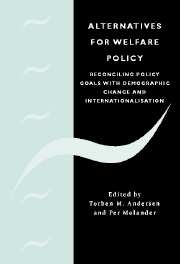Book contents
- Frontmatter
- Contents
- List of contributors
- Preface
- 1 Introduction
- 2 International integration and the welfare state
- 3 The changing age structure and the public sector
- 4 Emigration from the Scandinavian welfare states
- 5 Productivity and costs in public production of services
- 6 Use of fees in the provision of public services in OECD countries
- 7 Privatisation of social insurance with reference to Sweden
- 8 Occupational welfare
- 9 Pathways to retirement and retirement incentives in Sweden
- 10 Social insurance and redistribution
- 11 Assessing the effect of introducing welfare accounts in Sweden
- 12 Taxation in a global economy
- 13 Taxation and education investment in the tertiary sector
- 14 Debt strategies for Sweden and Europe
- 15 Policy options for reforming the welfare state
- Index
- References
13 - Taxation and education investment in the tertiary sector
Published online by Cambridge University Press: 22 September 2009
- Frontmatter
- Contents
- List of contributors
- Preface
- 1 Introduction
- 2 International integration and the welfare state
- 3 The changing age structure and the public sector
- 4 Emigration from the Scandinavian welfare states
- 5 Productivity and costs in public production of services
- 6 Use of fees in the provision of public services in OECD countries
- 7 Privatisation of social insurance with reference to Sweden
- 8 Occupational welfare
- 9 Pathways to retirement and retirement incentives in Sweden
- 10 Social insurance and redistribution
- 11 Assessing the effect of introducing welfare accounts in Sweden
- 12 Taxation in a global economy
- 13 Taxation and education investment in the tertiary sector
- 14 Debt strategies for Sweden and Europe
- 15 Policy options for reforming the welfare state
- Index
- References
Summary
Introduction
The public sector massively intervenes in the education sector in practically all OECD countries. Via free public provision of education, transfers to students, or high subsidies on education, the government strongly influences private education decisions. Education has elements of investment and consumption. For an analysis of public education policy the investment aspects are more relevant, and in what follows we will concentrate on these aspects.
Expenditures on education goods – from private and public sources – were 5.75 per cent of GDP on average in the OECD countries in 1998 (OECD, 2001a: 80). The variation in total expenditures across OECD countries was modest, ranging from 3.5 per cent of GDP in Turkey and 4.6 per cent in the Netherlands, to 7.0 per cent in Korea and 7.2 per cent in Denmark.
The public sector carries the lion's share of the costs of education in most OECD countries. In many countries primary and secondary education is financed almost exclusively by the public sector. An interesting fact is that the top group in terms of total expenditures includes countries with among the largest shares of public funding, like Sweden and Denmark, as well as countries with among the smallest public financing shares, like Korea and the USA (cf. OECD, 2001a: 93).
As has been illustrated in chapter 6, roughly a quarter of the education-goods expenditures are made on tertiary education; the OECD average is 1.59 per cent of GDP.
- Type
- Chapter
- Information
- Alternatives for Welfare PolicyCoping with Internationalisation and Demographic Change, pp. 305 - 327Publisher: Cambridge University PressPrint publication year: 2003



